According to Giving USA, foundations gave out more than $75 billion in grants in 2019, up $500 million from 2018.
For private family foundations and corporate foundations, public grantmaking charities, and community funds, big funding means big impacts.
But it also means lots of grant management headaches and inefficiencies. From designing applications, pursuing outreach, and reviewing proposals to awarding grant funds and tracking outcomes, the grants process is full of administrative details and potential missteps.
So, how do foundations manage grants successfully?
Because Submittable works with hundreds of foundations focused on charitable giving, we’ve seen first-hand what works best for funders of all kinds. Here are seven steps to help your foundation manage grants with minimal stress and for maximum impact.
- Clearly define your mission
- Design a just-right grant application process
- Promote your call and support applicants
- Implement an application review process
- Select and notify your grantees
- Award grant funding
- Streamline reporting to assess outcomes and impact
1. Clearly define your mission
The first step of any grantmaking process is to clearly and explicitly articulate your organization’s mission and goals.
Your mission statement is your foundation’s “why”—it should be specific, clear, and lend itself to actionable goals.
- The Scripps Howard Foundation aims “to create a better-informed world through journalism education and childhood literacy.”
- The Jerome Foundation “seeks to contribute to a dynamic and evolving culture by supporting the creation, development, and production of new works by early career/emerging artists.”
- The Latino Community Foundation “exists to unleash the power of Latinos in California.”
As philanthropy expert Kris Putnam-Walker observes, you can’t build a good strategy if you’re not clear why you’re building it. That is, without your “why” as a guiding principle, your specific plans (the “how”) might be too broad or too narrow.

2. Design a just-right grant application process
Increasingly, foundations are aware of the additional (and potentially unnecessary) workloads their grant management practices and due diligence requirements place upon busy nonprofits.
In its guide for foundations on good operational practices, Guidestar suggests that funders focus on simplicity, flexibility, rigor (balanced with realism), and conscientiousness to reduce the strain on nonprofits.
Following that idea: a concise, thoughtful grant application process sets the groundwork for a productive relationship between grantees and funders. It signals that you value your applicants’ time and sets a strong foundation for productive communication and partnerships in the future.
Both the application format and the information it requests should be designed to save applicants time and gather only the most useful and important information–information you’ll actually need to make a decision.
Provide clear grant guidelines
Potential grantees appreciate a transparent view into how your foundation will select grant recipients. The more guidance you can give them, the more likely that you’ll get good-fit, higher-quality applications.
Make your grant guidelines easy to find, thorough, and consistent. Use clear language, sections, bullets, and bold-face type to draw out important information.
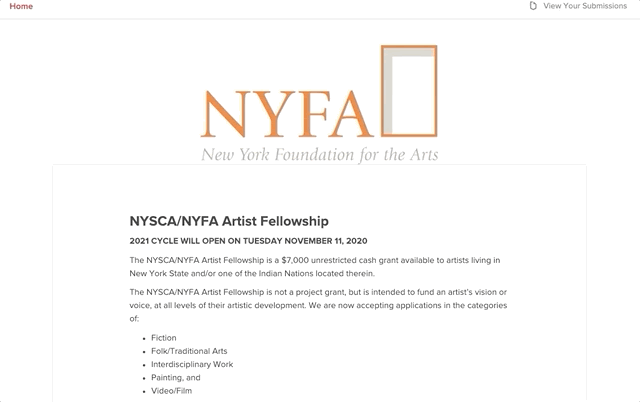
If you use a rubric or easy shareable grants scoring system, consider making it public.
Importantly, you’ll want to be clear about which nonprofits are–and aren’t–eligible for your foundation’s grant. (In most cases, donations to individuals are not tax-exempt for foundations and are therefore much less common; see IRS guidelines here.)
With Submittable’s eligibility quizzes, you can quickly screen out any applicants who don’t qualify for your grant, saving time for both them and your review team.
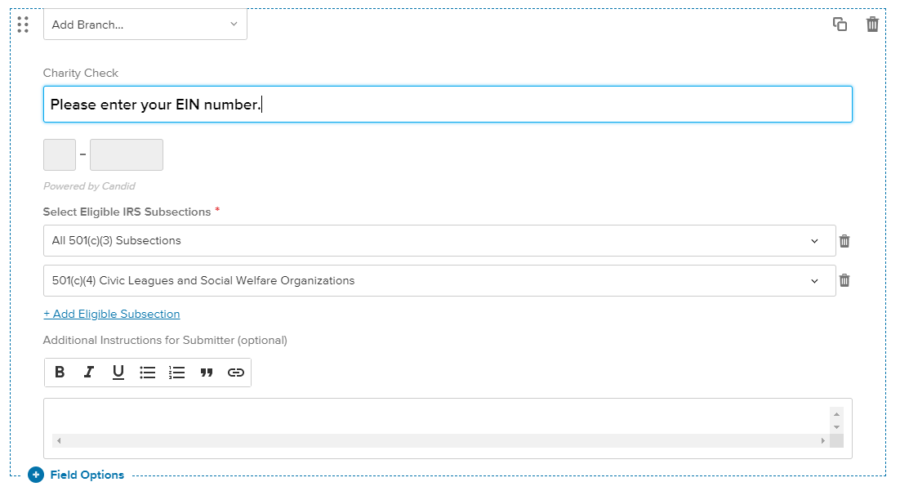
Create a user-friendly online application form
Submittable’s grant management software for foundations makes it easy to build an online grant application form that’s not only intuitive for grantseekers but also accessible and attractive. Plus, the system keeps all documentation centralized, including all application data, reviewer feedback, and related correspondence.
You can improve the completion rate of your application forms (and have more proposals to choose from) by limiting questions and requests to only those that are truly necessary.
Shavonn Richardson has identified several essential questions for grant applications:
- Tell us about your organization.
- What problem/issue/community need are you addressing?
- Tell us about your program/project.
- What expenses are associated with this program/project?
- How will you measure impact?
Any questions you include beyond these should truly meet a mission-related or reporting requirement.

You can also streamline the process and get a larger pool of completed applications by issuing a very short initial application and then sending a more comprehensive form to final round prospects.
3. Promote your call and support applicants
For grantmakers looking to bring about real change, diversity, equity, and inclusion (DEI) is more than a buzz-acronym.
To receive a diverse range of applicants, especially when launching a new program, your foundation staff and board need to (1) spread the word through outreach and (2) be prepared to support applicants with information or even technical support.
Beyond creating an simple, intuitive, and accessible grant application form, an inclusive outreach strategy should include:
- Partnering with other groups that serve the diverse populations you want to reach
- Asking former grantees to share your application in their communities
- Trying a new social media strategy, with targeted marketing and hashtags
- Holding and recording information sessions for a variety of groups
- Making sure your website is easy to find and navigate
- Offering translation or applications in multiple languages
Offer information sessions
Info sessions are an important part of promoting your call for applications and supporting applicants. These sessions should include an overview of your application process, examples of strong applications, important dates and deadlines, and time for Q&A. Record each session and make the recordings available afterwards for potential applicants who can’t attend.
Be available, responsive, and flexible
As applications begin to come in, be sure to confirm application receipt and make sure potential grantees understand what to expect next. Submittable can automate this step with templated emails so you can keep your messaging timely and professional from the start.
Post contact information in several places, including the main page of your website, the grants information page, and the application itself. Providing multiple contacts is useful if different members of your team will be handling specific correspondence. Hiding contact info won’t cut down on the inquiries your foundation receives. Instead, it can result in poorer quality applications and frustrated applicants.
In some cases, your foundation may want to make adjustments based on learning from early applications. For example, if you get the same question from applicants more than once, add the answer to your website and grant application form. You may also want to update the application itself.
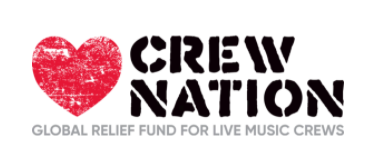
As Elisa Morimoto, Director of Operations at Music Forward and the Crew Nation grant facilitator notes, “being able to see what’s happening in the application is important—so is listening to outreach. The team at Submittable got applicant questions over to us so we could add instructions or add guidance. Just being responsive and being able to be flexible is very critical.”
Anticipate technical support needs
Grantees may run into technical issues that can be time-consuming for your foundation’s team to address. Create a best practices list, share technical tips and tricks, and direct applicants to the best resources.
Submittable’s plans can include top-notch technical support for both foundations and their applicants.
4. Implement an application review process
Well-designed application review is at the heart of your grant program’s success. A winning process for your foundation will be well-planned, with an emphasis on collaboration, fairness, and teamwork.
Put together a diverse review team
Your review team, including your foundation’s board members, staff, and external or volunteer reviewers, are indispensable to the grants management process.
Your reviewers may fill any of the following roles, at earlier or later stages, alone or in teams:
- Determining eligibility
- Grouping applications by focus, specialty, or request amount
- Evaluating specific criteria within each application
- Scoring and writing reviews and critiques
- Moving proposals between stages or narrowing a pool of applicants
- Following up on references and relevant fact checking
- Contacting applicants for additional information
Does your review team include people with a broad range of identities, experiences, and perspectives?
When your decision-makers are diverse and their opinions are equally valued, it’s much more likely that you can expand and improve your foundation’s reach through grant funds.
To build a diverse and inclusive review team:
- Inventory your workplace culture. Determine where you have gaps.
- Clarify your intentions. Why is DEI important to your organization?
- Do your homework. Research best approaches for attracting the reviewers you want.
- Communicate what you’re offering. What are the requirements and compensation?
- Be authentic. Be sure you’re not pursuing DEI merely for the optics.
Optimize review assignments
To set your review team up for success:
- Try to spread the work around evenly among reviewers, with consideration for the quantity and length of applications.
- Assign applications to specific reviewers with the appropriate expertise.
- Aim for a minimum of at least two reviewers per application. Having enough people sharing the load can protect reviewers against fatigue that results in inconsistency or unfairness.
- Make sure reviewers have access to all the materials they need, including full application materials, any review forms, and shared communication with team members.
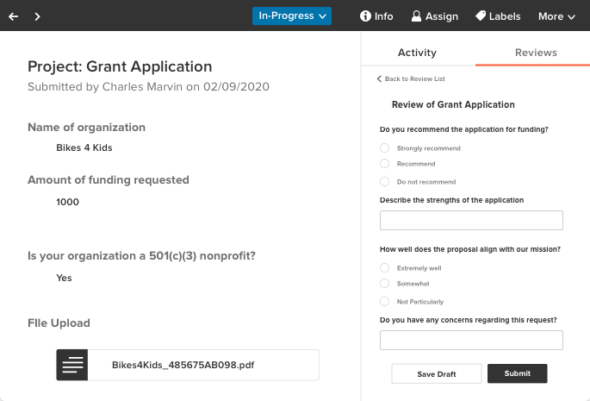
Set up a review system
There are a variety of legitimate and effective ways to evaluate applications for grants, and you can use more than one of them in combination:
- Yes/no/maybe voting
- Rubrics, point scales, and numeric voting
- Question and answer forms
- Weighted evaluation forms
- In-depth reports and critiques
- In-person meetings and deliberation
- Interviews and site visits
- Documented history with returning grantees
Many foundations incorporate these review approaches in stages and (depending on program and organization size) among various groups of reviewers, classified by grants specialty.
Grant management software like Submittable can centralize and systematize this and every other step of the grant review process.

If your foundation is anything like the 187 foundations surveyed by the Center for Effective Philanthropy, your team is looking for grant applications that:
- indicate the nonprofit applicant is aligned with your mission,
- demonstrate the applicant staff are experienced at putting grant funds to good use, and
- lists resources they already have in terms of time and money.
Mitigate bias
Any decision-making process that relies on humans (or even machines designed by humans) will involve some degree of bias. While no approach is foolproof, the following strategies can help minimize bias and keep your foundation’s grant award process as fair and equitable as it can be:
Be explicit
If you don’t acknowledge bias, it’s impossible to fight it. Your foundation should integrate inclusivity and impartiality into its larger mission statement and draft specific language around this topic.
Make a plan to proactively mitigate bias and deal with situations when they arise. The more of this policy you can make public the greater your accountability and better your transparency will be.
Eliminating bias also depends on open communication among reviewers about team-wide goals. It’s a good idea to have an in-person or video conversation with reviewers about your specific policies, the importance of fairness, and any concerns or questions they might have. documentation.
Systematize bias mitigation
In the application form, make demographic questions optional and provide a full range of options, including the ability for applicants to self-identify.
Keep demographic and contact information confidential from reviewers in early rounds to preserve the anonymity of applicants.

Generally, you should limit reviewers to seeing only the information they need to make informed and fair evaluations. (Different reviewers need different amounts and types of information, so Submittable allows you to create different permission levels.)
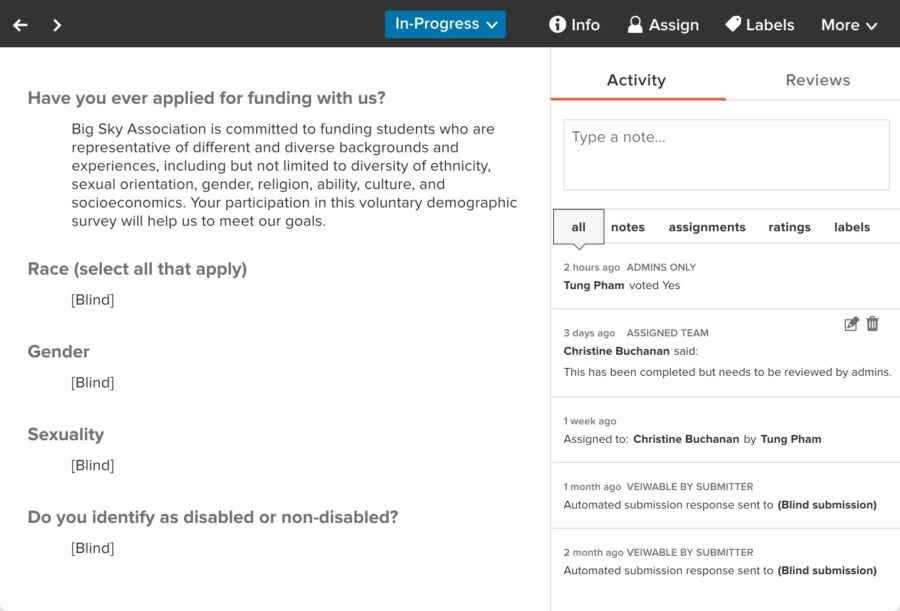
Manage disparities
Be on the lookout for big inconsistencies among scoring or reviews. For example, if one review is dramatically at odds with the majority, this review likely deserves attention; either the group or the individual might be demonstrating bias.
Using Submittable’s scoring system allows LaTrena Artist, Program Director for the Jeannette Rankin Women’s Scholarship Fund (JRF) to quickly skim applicant scores and look for outliers that could be the result of conscious or unconscious bias.
“When I see that seven other reviewers have scored an applicant at a 40, and then all of a sudden I see someone gave her a 12, I’ll question it,” she explains. “On that backend, I’m appreciative for that rubric because it can help me pull people out.”
5. Select and notify your grantees
Every foundation’s grantee selection process is unique. When working with reviewers (or scored reviews) that express multiple viewpoints, you may choose to let your board make the final call.
In other cases, you might work with all reviewers until everyone can agree (or at least concede) to a group decision.
Either way, it’s likely your foundation uses some form of in-person or video meeting to discuss and deliberate over final choices.
The more prepared everyone is to discuss individual applicants and support their respective viewpoints, the more productive these meetings will be.
During the meeting, you’ll want everyone to have access to an online grant management system like Submittable that makes all the relevant application materials and reviews handy.

Further, in advance of discussion, it’s useful to agree upon reference points (like a rubric) that will help drive decisions (and perhaps help break deadlocks).
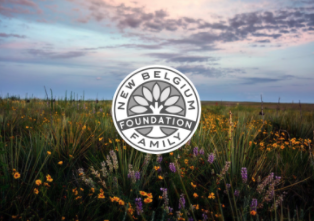
Once you’ve made your final selections, it’s time to notify applicants.
Let all your applicants know about your decision(s) in a thoughtful and gracious way. Every applicant, even those you don’t fund, are potential advocates for your foundation and future grantees.
For selected grantees, share important information they’ll need to move forward.

6. Award grant funding
Depending on the grant program, your foundation may cut checks for grantees as soon as decisions are announced. In other cases, you might deliver awards on a specific timeline or after project criteria has been met.
However your foundation handles the disbursement of funding, make sure your grantees know exactly what to expect and what is required of them at each stage.
Having a system in place to manage your budget and keep track of where funded organizations are in the award cycle allows both your foundation and the nonprofit to keep close tabs on the bottom line at all times.

If your foundation requires completed project work or documentation before grants are awarded, make it convenient for grantees to submit materials digitally.
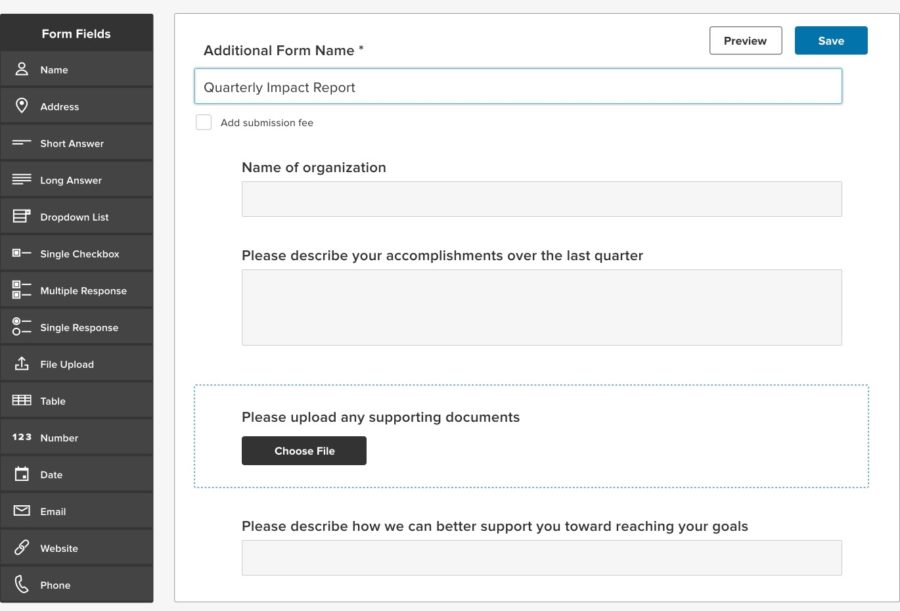
In a certain sense, the award process is the beginning of the reporting process for both your foundation and your grantees. It’s essential that both parties keep organized and detailed records as money begins to flow so that outcomes and impact can be accurately tracked—and just in case an audit becomes necessary.
7. Streamline reporting to assess outcomes and impact
What if the reporting process didn’t have to be tedious for your foundation or arduous for nonprofits and grantees? Just like the best grant applications only require necessary information, grant reports should be streamlined and focused to save everyone time.
As Marcella J. Tillett, Vice President of Programs and Partnerships for Brooklyn Community Foundation, notes, reducing workload for grantees is essential, especially when sudden need arises, as it did with the coronavirus pandemic.

“Even before our COVID-19 response, she says, “we’ve been working to minimize the burden on nonprofits because we understand that even the process of applying and responding to RFPs, that’s labor. As staff, we try to develop trusting partnerships with nonprofits so that as things emerge, whether it’s an emergency like this or just everyday work, they feel like they can trust us and come to us.”
With a bit of foresight and planning, your streamlined grant reporting practices can improve your relationships with grantees, improve outcomes, and uncover the true impact of your funds.
The clearer you are on what you want to measure, the more focused your application and follow-up reporting will be.
Otherwise, the key is to simplify collection and analysis. Specifically:
- Don’t ask applicants to submit a piece of information—like contact info, website, and 501C-3 status—more than once. (Submittable’s smart forms can help with this.)
- Use a comprehensive online grant management system like Submittable to automate data processing and reporting.
- Consider whether long reporting forms could be shortened and supplemented (or replaced) by a phone call or site visit.
- Consider alternative reporting formats to written reports. For example, photos or video may provide both due diligence and great marketing materials. (Submittable accepts over 50 file types, including photo, video, and audio.)
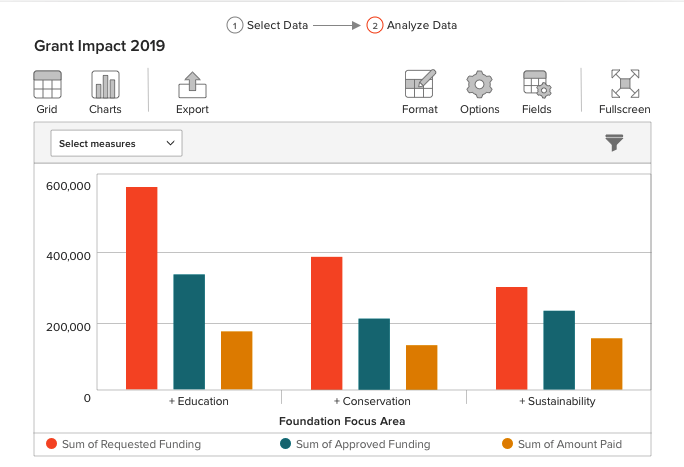
Actively seek feedback on your reporting practices. You need to know what’s working and what’s not to better serve nonprofits and better quantify impact.
The following questions, based on PEAK Grantmaking’s recommendations for reviewing grant reporting, have been adapted here to model a guided, collaborative discussion between your foundation and the organizations you serve:
- Were grant dollars used as intended?
- Is there a record of the relationship between the grantee and grantor?
- What learning opportunities emerge from this grant for the foundation? For the nonprofit?
- Does this partnership make sense moving forward?
- What will best help the grantee succeed?
- Which stories are important to share?
- What knowledge from other projects can be applied to improve outcomes not just for this nonprofit, but for the projects in this field?
- How can we get better at what we do? What are the implications of our approach and strategy?
- How do our relationships fundamentally shift power and model new ways of working together?
Are your grant reporting strategies truly impact-focused?
Learn 10 key strategies for grant reporting in our free guide.
Bringing it all together for great outcomes
For your foundation to lead the charge in supporting innovative nonprofits and spurring community change, it’s time to think seriously about your grant management. The most effective giving is built on solid strategy, smart applications, thoughtful review, and expedient reporting. And each piece of the puzzle holds equal importance for your foundation.
Submittable can help you every step along the way. Our grant management software for foundations includes a full suite of tools designed to help foundations like yours make the grantmaking process efficient and effective.